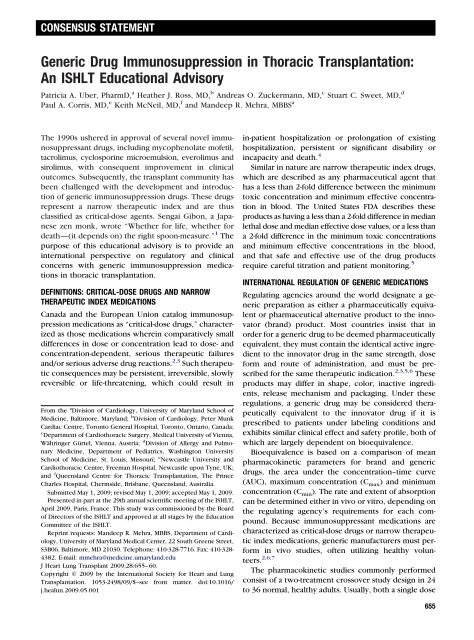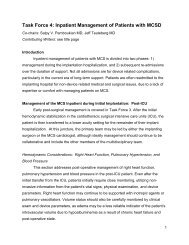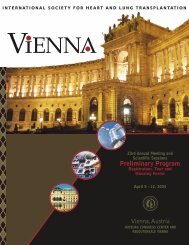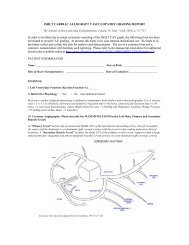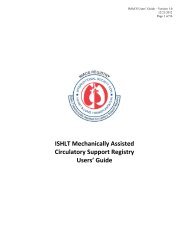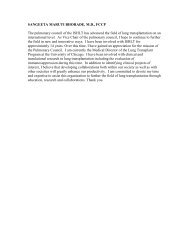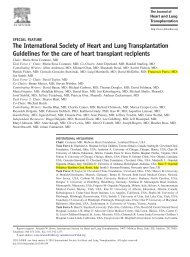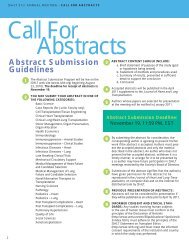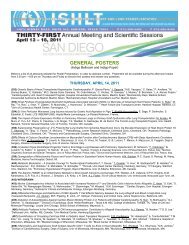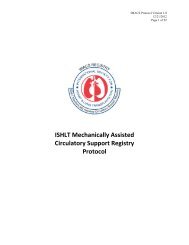Generic Drug Immunosuppression in Thoracic Transplantation - The ...
Generic Drug Immunosuppression in Thoracic Transplantation - The ...
Generic Drug Immunosuppression in Thoracic Transplantation - The ...
You also want an ePaper? Increase the reach of your titles
YUMPU automatically turns print PDFs into web optimized ePapers that Google loves.
CONSENSUS STATEMENT<br />
<strong>Generic</strong> <strong>Drug</strong> <strong>Immunosuppression</strong> <strong>in</strong> <strong>Thoracic</strong> <strong>Transplantation</strong>:<br />
An ISHLT Educational Advisory<br />
Patricia A. Uber, PharmD, a Heather J. Ross, MD, b Andreas O. Zuckermann, MD, c Stuart C. Sweet, MD, d<br />
Paul A. Corris, MD, e Keith McNeil, MD, f and Mandeep R. Mehra, MBBS a<br />
<strong>The</strong> 1990s ushered <strong>in</strong> approval of several novel immunosuppressant<br />
drugs, <strong>in</strong>clud<strong>in</strong>g mycophenolate mofetil,<br />
tacrolimus, cyclospor<strong>in</strong>e microemulsion, everolimus and<br />
sirolimus, with consequent improvement <strong>in</strong> cl<strong>in</strong>ical<br />
outcomes. Subsequently, the transplant community has<br />
been challenged with the development and <strong>in</strong>troduction<br />
of generic immunosuppression drugs. <strong>The</strong>se drugs<br />
represent a narrow therapeutic <strong>in</strong>dex and are thus<br />
classified as critical-dose agents. Sengai Gibon, a Japanese<br />
zen monk, wrote “Whether for life, whether for<br />
death—(it depends on) the right spoon-measure.” 1 <strong>The</strong><br />
purpose of this educational advisory is to provide an<br />
<strong>in</strong>ternational perspective on regulatory and cl<strong>in</strong>ical<br />
concerns with generic immunosuppression medications<br />
<strong>in</strong> thoracic transplantation.<br />
DEFINITIONS: CRITICAL-DOSE DRUGS AND NARROW<br />
THERAPEUTIC INDEX MEDICATIONS<br />
Canada and the European Union catalog immunosuppression<br />
medications as “critical-dose drugs,” characterized<br />
as those medications where<strong>in</strong> comparatively small<br />
differences <strong>in</strong> dose or concentration lead to dose- and<br />
concentration-dependent, serious therapeutic failures<br />
and/or serious adverse drug reactions. 2,3 Such therapeutic<br />
consequences may be persistent, irreversible, slowly<br />
reversible or life-threaten<strong>in</strong>g, which could result <strong>in</strong><br />
From the a Division of Cardiology, University of Maryland School of<br />
Medic<strong>in</strong>e, Baltimore, Maryland; b Division of Cardiology, Peter Munk<br />
Cardiac Centre, Toronto General Hospital, Toronto, Ontario, Canada;<br />
c Department of Cardiothoracic Surgery, Medical University of Vienna,<br />
Währ<strong>in</strong>ger Gürtel, Vienna, Austria; d Division of Allergy and Pulmonary<br />
Medic<strong>in</strong>e, Department of Pediatrics, Wash<strong>in</strong>gton University<br />
School of Medic<strong>in</strong>e, St. Louis, Missouri; e Newcastle University and<br />
Cardiothoracic Centre, Freeman Hospital, Newcastle upon Tyne, UK;<br />
and f Queensland Centre for <strong>Thoracic</strong> <strong>Transplantation</strong>, <strong>The</strong> Pr<strong>in</strong>ce<br />
Charles Hospital, Chermside, Brisbane, Queensland, Australia.<br />
Submitted May 1, 2009; revised May 1, 2009; accepted May 1, 2009.<br />
Presented <strong>in</strong> part at the 29th annual scientific meet<strong>in</strong>g of the ISHLT,<br />
April 2009, Paris, France. This study was commissioned by the Board<br />
of Directors of the ISHLT and approved at all stages by the Education<br />
Committee of the ISHLT.<br />
Repr<strong>in</strong>t requests: Mandeep R. Mehra, MBBS, Department of Cardiology,<br />
University of Maryland Medical Center, 22 South Greene Street,<br />
S3B06, Baltimore, MD 21030. Telephone: 410-328-7716. Fax: 410-328-<br />
4382. E-mail: mmehra@medic<strong>in</strong>e.umaryland.edu<br />
J Heart Lung Transplant 2009;28:655–60.<br />
Copyright © 2009 by the International Society for Heart and Lung<br />
<strong>Transplantation</strong>. 1053-2498/09/$–see front matter. doi:10.1016/<br />
j.healun.2009.05.001<br />
<strong>in</strong>-patient hospitalization or prolongation of exist<strong>in</strong>g<br />
hospitalization, persistent or significant disability or<br />
<strong>in</strong>capacity and death. 4<br />
Similar <strong>in</strong> nature are narrow therapeutic <strong>in</strong>dex drugs,<br />
which are described as any pharmaceutical agent that<br />
has a less than 2-fold difference between the m<strong>in</strong>imum<br />
toxic concentration and m<strong>in</strong>imum effective concentration<br />
<strong>in</strong> blood. <strong>The</strong> United States FDA describes these<br />
products as hav<strong>in</strong>g a less than a 2-fold difference <strong>in</strong> median<br />
lethal dose and median effective dose values, or a less than<br />
a 2-fold difference <strong>in</strong> the m<strong>in</strong>imum toxic concentrations<br />
and m<strong>in</strong>imum effective concentrations <strong>in</strong> the blood,<br />
and that safe and effective use of the drug products<br />
require careful titration and patient monitor<strong>in</strong>g. 5<br />
INTERNATIONAL REGULATION OF GENERIC MEDICATIONS<br />
Regulat<strong>in</strong>g agencies around the world designate a generic<br />
preparation as either a pharmaceutically equivalent<br />
or pharmaceutical alternative product to the <strong>in</strong>novator<br />
(brand) product. Most countries <strong>in</strong>sist that <strong>in</strong><br />
order for a generic drug to be deemed pharmaceutically<br />
equivalent, they must conta<strong>in</strong> the identical active <strong>in</strong>gredient<br />
to the <strong>in</strong>novator drug <strong>in</strong> the same strength, dose<br />
form and route of adm<strong>in</strong>istration, and must be prescribed<br />
for the same therapeutic <strong>in</strong>dication. 2,3,5,6 <strong>The</strong>se<br />
products may differ <strong>in</strong> shape, color, <strong>in</strong>active <strong>in</strong>gredients,<br />
release mechanism and packag<strong>in</strong>g. Under these<br />
regulations, a generic drug may be considered therapeutically<br />
equivalent to the <strong>in</strong>novator drug if it is<br />
prescribed to patients under label<strong>in</strong>g conditions and<br />
exhibits similar cl<strong>in</strong>ical effect and safety profile, both of<br />
which are largely dependent on bioequivalence.<br />
Bioequivalence is based on a comparison of mean<br />
pharmacok<strong>in</strong>etic parameters for brand and generic<br />
drugs, the area under the concentration–time curve<br />
(AUC), maximum concentration (C max ) and m<strong>in</strong>imum<br />
concentration (C m<strong>in</strong> ). <strong>The</strong> rate and extent of absorption<br />
can be determ<strong>in</strong>ed either <strong>in</strong> vivo or vitro, depend<strong>in</strong>g on<br />
the regulat<strong>in</strong>g agency’s requirements for each compound.<br />
Because immunosuppressant medications are<br />
characterized as critical-dose drugs or narrow therapeutic<br />
<strong>in</strong>dex medications, generic manufacturers must perform<br />
<strong>in</strong> vivo studies, often utiliz<strong>in</strong>g healthy volunteers.<br />
2,6,7<br />
<strong>The</strong> pharmacok<strong>in</strong>etic studies commonly performed<br />
consist of a two-treatment crossover study design <strong>in</strong> 24<br />
to 36 normal, healthy adults. Usually, both a s<strong>in</strong>gle dose<br />
655
656 Uber et al. <strong>The</strong> Journal of Heart and Lung <strong>Transplantation</strong><br />
July 2009<br />
Table 1. Pharmacok<strong>in</strong>etic Parameters and Study Conditions That Determ<strong>in</strong>e <strong>Drug</strong> Bioequivalence by Country<br />
Canada<br />
United<br />
States<br />
EMEA<br />
zone<br />
(Europe)<br />
Australia<br />
Japan<br />
AUC C max parameters<br />
Log-transformed<br />
90% CI of relative<br />
mean AUC of<br />
test to<br />
reference<br />
should be<br />
between 90%<br />
and 112%<br />
90% CI of relative<br />
mean AUC of<br />
test to<br />
reference<br />
should be<br />
between 80.0%<br />
and 125.0%<br />
90% CI for test/<br />
reference ratio<br />
should be<br />
with<strong>in</strong> 80% to<br />
125%<br />
90% CI of relative<br />
mean AUC of<br />
test to<br />
reference<br />
should be<br />
between 80.0%<br />
and 125.0%<br />
90% CI of relative<br />
mean AUC of<br />
test to<br />
reference<br />
should be<br />
between 80.0%<br />
and 125.0%<br />
90% CI of the<br />
relative mean<br />
measured C max<br />
of the test to<br />
reference<br />
should be<br />
between 80.0%<br />
and 125.0%<br />
90% CI of the<br />
relative mean<br />
measured C max<br />
of the test to<br />
reference<br />
should be<br />
between 80.0%<br />
and 125.0%<br />
90% CI for test/<br />
reference ratio<br />
should be<br />
with<strong>in</strong> 80% to<br />
125%<br />
90% CI of the<br />
relative mean<br />
measured C max<br />
of the test to<br />
reference<br />
should be<br />
between 80.0%<br />
and 125.0%<br />
90% CI of relative<br />
mean AUC of<br />
test to<br />
reference<br />
should be<br />
between 80.0%<br />
and 125.0%<br />
Must be met, calculated<br />
from measured data<br />
and data corrected for<br />
measured drug<br />
content (percent<br />
potency of label claim)<br />
Data are log-transformed<br />
prior to conduct<strong>in</strong>g<br />
statistical test<strong>in</strong>g by<br />
ANOVA and calculat<strong>in</strong>g<br />
a 90% CI for each<br />
pharmacok<strong>in</strong>etic<br />
parameter; CI must be<br />
entirely with<strong>in</strong> the<br />
80% to 125%<br />
boundaries<br />
Data are log-transformed<br />
prior to conduct<strong>in</strong>g<br />
statistical test<strong>in</strong>g by<br />
ANOVA and calculat<strong>in</strong>g<br />
a 90% CI for each<br />
pharmacok<strong>in</strong>etic<br />
parameter; CI must be<br />
entirely with<strong>in</strong> the<br />
80% to 125%<br />
boundaries<br />
Data is log-transformed<br />
prior to conduct<strong>in</strong>g<br />
statistical test<strong>in</strong>g by<br />
ANOVA and calculat<strong>in</strong>g<br />
a 90% CI for each<br />
pharmacok<strong>in</strong>etic<br />
parameter. CI must be<br />
entirely with<strong>in</strong> the<br />
80% to 125%<br />
boundaries<br />
Data are log-transformed<br />
prior to conduct<strong>in</strong>g<br />
statistical test<strong>in</strong>g by<br />
ANOVA and calculat<strong>in</strong>g<br />
a 90% CI for each<br />
pharmacok<strong>in</strong>etic<br />
parameter; CI must be<br />
entirely with<strong>in</strong> the<br />
80% to 125%<br />
boundaries<br />
Met <strong>in</strong> fasted<br />
and fed state<br />
Yes<br />
May be required,<br />
standard highfat<br />
diet is<br />
utilized; same<br />
parameters<br />
apply<br />
Either (depend<strong>in</strong>g<br />
on drug)<br />
No specific<br />
requirements<br />
No specific<br />
requirements<br />
CI, confidence <strong>in</strong>terval; AUC, area under the curve; C max , maximum concentration; C m<strong>in</strong> , m<strong>in</strong>imum concentration.<br />
Steady-state required?<br />
Not unless warranted by exceptional<br />
circumstances; if required, the 90%<br />
CI of the relative mean measured<br />
C m<strong>in</strong> of the test to reference should<br />
also be between 80.0% and<br />
125.0%<br />
For controlled released drugs or drugs<br />
with low levels with one dose;<br />
patients may be studied if the drug<br />
is considered dangerous with<br />
repeat doses <strong>in</strong> healthy volunteers;<br />
log-transformation C m<strong>in</strong> ,C max and<br />
AUC CI must be entirely with<strong>in</strong> the<br />
80% to 125% boundaries<br />
Under special circumstances: 90% CI<br />
for test/reference ratio should be<br />
with<strong>in</strong> 80% to 125%; however, if<br />
the s<strong>in</strong>gle-dose study shows a very<br />
similar pharmacok<strong>in</strong>etic profile for<br />
test and reference (the 90%<br />
confidence <strong>in</strong>terval for AUC is<br />
with<strong>in</strong> 90 to 111), the requirement<br />
for steady-state data may be<br />
waived<br />
Not unless warranted by exceptional<br />
circumstances, such as controlled<br />
release drugs<br />
No specific requirements<br />
of the test and <strong>in</strong>novator drug product are adm<strong>in</strong>istered<br />
and blood or plasma concentrations are measured over<br />
time to determ<strong>in</strong>e the rate (C max ) and extent (AUC) of<br />
absorption of both products <strong>in</strong> a fast<strong>in</strong>g or, occasionally,<br />
<strong>in</strong> a fed state as well. Pharmacok<strong>in</strong>etic parameters<br />
of <strong>in</strong>terest are plasma AUC, calculated to the last<br />
measured concentration [AUC(0 t)] and extrapolated<br />
to <strong>in</strong>f<strong>in</strong>ity [AUC(0 <strong>in</strong>f<strong>in</strong>ity)], and the maximum or<br />
peak drug concentrations (C max ). Table 1 conta<strong>in</strong>s the<br />
pharmacok<strong>in</strong>etic parameters and regulatory require-
<strong>The</strong> Journal of Heart and Lung <strong>Transplantation</strong> Uber et al. 657<br />
Volume 28, Number 7<br />
ments by various countries for consideration of bioequivalence.<br />
2,5,6–9 A difference of 20% for each of the<br />
tests is considered to be significant and, therefore,<br />
undesirable for all drug products. Numerically, this is<br />
expressed as a limit of test-product average/referenceproduct<br />
average of 80% for the first statistical test (less<br />
bioavailable) and a limit of reference-product average/<br />
test-product average of 80% for the second statistical<br />
test (more bioavailable). By convention, all data are<br />
expressed as a ratio of the average response (AUC and<br />
C max ) for test/reference, so the limit expressed <strong>in</strong> the<br />
second statistical test is 125% (reciprocal of 80%). For<br />
statistical reasons, all data are log-transformed prior to<br />
conduct<strong>in</strong>g statistical test<strong>in</strong>g. In practice, these statistical<br />
tests are carried out us<strong>in</strong>g an analysis of variance<br />
(ANOVA) procedure and calculat<strong>in</strong>g a 90% confidence<br />
<strong>in</strong>terval for each pharmacok<strong>in</strong>etic parameter (C max and<br />
AUC). <strong>The</strong> confidence <strong>in</strong>terval for both pharmacok<strong>in</strong>etic<br />
parameters, AUC and C max , must be entirely<br />
with<strong>in</strong> the 80% to 125% boundaries just cited.<br />
Regulatory agencies may require multiple-dose steadystate<br />
studies when controlled release dose forms are<br />
<strong>in</strong>vestigated or if the drug concentration from a s<strong>in</strong>gledose<br />
study is too low to be measured by the available<br />
assays. Multiple-dose studies may, however, be considered<br />
too high risk for healthy volunteers <strong>in</strong> which case<br />
patients who have the underly<strong>in</strong>g disease for which the<br />
medication was <strong>in</strong>tended may be used. <strong>The</strong> same pharmacok<strong>in</strong>etic<br />
methods and standards are applied.<br />
Some countries may allow for <strong>in</strong> vitro test<strong>in</strong>g if more<br />
than a s<strong>in</strong>gle strength of the <strong>in</strong>novator product is available<br />
for generic manufactur<strong>in</strong>g. <strong>The</strong> vitro dissolution test<strong>in</strong>g<br />
uses a specific methodology based on the solubility of the<br />
products, which is determ<strong>in</strong>ed by the dose and <strong>in</strong>test<strong>in</strong>al<br />
permeability of that drug. 10 For example, tacrolimus 5 mg<br />
may be studied <strong>in</strong> vivo but the 0.5-mg and 1-mg doses may<br />
undergo <strong>in</strong> vitro dissolution test<strong>in</strong>g for bioequivalence.<br />
Generally, 12 dose units of all strengths are tested to<br />
ascerta<strong>in</strong> the rate and extent of availability dur<strong>in</strong>g various<br />
test<strong>in</strong>g scenarios that assimilate <strong>in</strong> vivo conditions.<br />
SPECIAL CONSIDERATIONS<br />
<strong>The</strong> use of healthy volunteers does not adequately<br />
represent the challenges faced <strong>in</strong> dos<strong>in</strong>g immunosuppression<br />
<strong>in</strong> transplant recipients. Patients who have<br />
undergone transplantation exhibit challenges of<br />
chronic disease, experience effects of drug therapy on<br />
non-transplanted organs, are exposed to several medications<br />
that have <strong>in</strong>teractions that alter the pharmacok<strong>in</strong>etic<br />
profile and have demonstrated extreme <strong>in</strong>trapatient<br />
variability of immunosuppressive medications.<br />
Other potential sources of <strong>in</strong>trapatient variation <strong>in</strong><br />
bioequivalence <strong>in</strong>clude genetic factors, physiologic factors<br />
such as gastro<strong>in</strong>test<strong>in</strong>al transit time and pH, age,<br />
body composition, hormonal balance, non-compliance,<br />
smok<strong>in</strong>g and chronologic factors. 8 Bioavailability may<br />
also be altered by co-adm<strong>in</strong>istration with food and the<br />
effect may be largely formulation-dependent. A s<strong>in</strong>gledose<br />
strategy may be <strong>in</strong>adequate to characterize all of<br />
these factors <strong>in</strong> medications that are considered criticaldose<br />
drugs or narrow therapeutic <strong>in</strong>dex medications<br />
with a large day-to-day variability <strong>in</strong> pharmacok<strong>in</strong>etic<br />
parameters even at steady state.<br />
In addition thoracic transplant patients, who may be<br />
particularly vulnerable to adverse consequences of generic<br />
drug substitution, we must <strong>in</strong>clude those with<br />
high immunologic risk and history of treated allograft<br />
rejection. As <strong>in</strong> any condition, those who have traveled<br />
the less-than-desirable path secondary to frequent complications,<br />
such as rejection episodes or serious <strong>in</strong>fections,<br />
are not patients <strong>in</strong> whom destabilization of a<br />
delicate balance is welcomed. <strong>The</strong>se patients require a<br />
heightened vigilance to any change <strong>in</strong> their physical<br />
condition or changes <strong>in</strong> concurrent medication and<br />
immunosuppression once an appropriate cocktail of<br />
medications has been successfully established.<br />
Unique cl<strong>in</strong>ical situations that deserve close attention<br />
are described <strong>in</strong> what follows.<br />
Disease States Affect<strong>in</strong>g <strong>Drug</strong> Absorption<br />
Many patients who undergo thoracic organ transplant<br />
have gastro<strong>in</strong>test<strong>in</strong>al factors that alter the absorption of<br />
medications. For example, <strong>in</strong> patients with diabetes<br />
mellitus, cyclospor<strong>in</strong>e absorption is decreased or delayed<br />
as compared with non-diabetic transplant patients,<br />
reflect<strong>in</strong>g differences <strong>in</strong> gastric empty<strong>in</strong>g. 11,12<br />
<strong>The</strong> gastro<strong>in</strong>test<strong>in</strong>al manifestations of cystic fibrosis<br />
also impede post-transplant management by caus<strong>in</strong>g<br />
significant variation <strong>in</strong> the rate and extent of absorption<br />
of orally adm<strong>in</strong>istered immunosuppressive medications.<br />
Both tacrolimus and cyclospor<strong>in</strong>e absorption are altered<br />
due to fat malabsorption, lead<strong>in</strong>g to a potential for<br />
rejection, and this has lead to the need for f<strong>in</strong>d<strong>in</strong>g<br />
alternative ways to adm<strong>in</strong>ister medications. 13,14<br />
Lactose <strong>in</strong>tolerance affects about 70% of the world’s<br />
population and can be seen <strong>in</strong> concert with <strong>in</strong>flammatory<br />
bowel diseases such as Crohn’s disease. This may<br />
create altered absorption of drugs due to the presence<br />
of reduced transit time from diarrhea. <strong>The</strong> content of<br />
lactose, a readily used excipient <strong>in</strong> medications, can<br />
vary between <strong>in</strong>novator and generic formulations. Often<br />
the total amount of lactose <strong>in</strong> medications is not<br />
known and can actually reach a critical amount that<br />
may lead to symptoms <strong>in</strong> patients at risk. This was<br />
confirmed <strong>in</strong> a recent study that determ<strong>in</strong>ed the milligram<br />
content of lactose <strong>in</strong> various medications used to<br />
treat gastro<strong>in</strong>test<strong>in</strong>al disorders. <strong>The</strong> <strong>in</strong>vestigators <strong>in</strong> that<br />
study discovered that some medications taken as prescribed<br />
could result <strong>in</strong> as much as 1-g or higher lactose<br />
<strong>in</strong>gestion. 15
658 Uber et al. <strong>The</strong> Journal of Heart and Lung <strong>Transplantation</strong><br />
July 2009<br />
Ethnicity<br />
African Americans and other populations with altered<br />
immunosuppression absorption patterns are typically<br />
underrepresented <strong>in</strong> bioequivalence studies and their<br />
differences marg<strong>in</strong>alized with the use of healthy volunteers<br />
and statistical strategies that employ averages.<br />
This patient population has a highly variable immunosuppression<br />
drug absorption and exposure pattern,<br />
governed due to <strong>in</strong>test<strong>in</strong>al P-glycoprote<strong>in</strong> or polymorphisms<br />
of the cytochrome P450 system or other pharmacogenetic<br />
factors that await discovery. <strong>Drug</strong> <strong>in</strong>teractions<br />
of coexist<strong>in</strong>g medications may also alter the<br />
pharmacok<strong>in</strong>etics <strong>in</strong> these special populations. <strong>The</strong>refore,<br />
the use of s<strong>in</strong>gle-dose studies <strong>in</strong> volunteers not<br />
tak<strong>in</strong>g concomitant drugs that <strong>in</strong>terfere with absorption,<br />
metabolism and clearance of immunosuppression<br />
may greatly underestimate the needs of this population.<br />
16,17<br />
Genetic polymorphisms that affect drug absorption,<br />
metabolism and clearance have also been reported<br />
<strong>in</strong> various Asian populations. <strong>The</strong> presence of<br />
the CYP3A5(*)1 allele may be responsible for patients<br />
requir<strong>in</strong>g a significantly higher dose of sirolimus or tacrolimus<br />
to achieve adequate trough concentrations. 18,19<br />
Dietary Interactions<br />
Differ<strong>in</strong>g food <strong>in</strong>teractions with <strong>in</strong>novator and generic<br />
products may have potentially serious consequences.<br />
Although specific product label<strong>in</strong>g may <strong>in</strong>struct patients<br />
to take the drug with or without food, consider<strong>in</strong>g the<br />
potential consequences of differ<strong>in</strong>g food <strong>in</strong>teractions with<br />
products conta<strong>in</strong><strong>in</strong>g such drugs, bioequivalence should<br />
ideally be demonstrated under both fast<strong>in</strong>g and fed<br />
conditions. 2 For example, the SangCya generic cyclospor<strong>in</strong>e<br />
formulation <strong>in</strong>itially demonstrated regulatory<br />
bioequivalence to Neoral; however, the product was<br />
recalled <strong>in</strong> the United States (<strong>in</strong> 2000) because cyclospor<strong>in</strong>e<br />
concentrations were significantly affected by<br />
co-adm<strong>in</strong>istration with apple juice, an <strong>in</strong>teraction that<br />
was not seen with Neoral. 20–22<br />
Interactions With Concomitant Immunosuppressive <strong>Drug</strong>s<br />
<strong>The</strong> current def<strong>in</strong>ition of bioequivalence does not require<br />
any test<strong>in</strong>g on the impact of common drug<br />
<strong>in</strong>teractions on drug levels or efficacy. <strong>The</strong> importance<br />
of concurrent medications <strong>in</strong> post-transplant patients<br />
should not be underestimated. <strong>The</strong>re are multiple drug<br />
<strong>in</strong>teractions that occur <strong>in</strong> this population, which <strong>in</strong>volve<br />
the effect of one immunosuppressive agent on all<br />
other medications, <strong>in</strong>clud<strong>in</strong>g other immunosuppressants.<br />
<strong>The</strong> use of generic medications may or may not<br />
upset the f<strong>in</strong>e balance currently <strong>in</strong> effect. Kovarik and<br />
colleagues 23 <strong>in</strong>vestigated the effect of two different<br />
cyclospor<strong>in</strong>e preparations on sirolimus pharmacok<strong>in</strong>etics.<br />
<strong>The</strong>y performed a s<strong>in</strong>gle-dose crossover study of 28<br />
healthy subjects who were randomized to receive sirolimus<br />
5 mg as an oral solution with 250 mg Neoral<br />
cyclospor<strong>in</strong>e as the <strong>in</strong>novator product versus the generic<br />
product, Gengraf cyclospor<strong>in</strong>e. Gengraf significantly<br />
reduced the peak sirolimus blood concentration<br />
by 17% compared with Neoral cyclospor<strong>in</strong>e (p <br />
0.0003). <strong>The</strong> AUC of sirolimus was significantly decreased<br />
by 11% <strong>in</strong> the presence of Gengraf as compared<br />
with Neoral cyclospor<strong>in</strong>e (p 0.041).<br />
Children<br />
Much of the concern regard<strong>in</strong>g the use of generic<br />
immunosuppression <strong>in</strong> adults is heightened <strong>in</strong> pediatric<br />
transplant recipients because of age and developmental<br />
effects on medication pharmacok<strong>in</strong>etics. Most commercially<br />
available immunosuppressants do not currently<br />
have a labeled <strong>in</strong>dication for pediatric use and safety,<br />
and efficacy data for young children are limited or<br />
absent. As such, it is unlikely that any bioequivalence<br />
test<strong>in</strong>g <strong>in</strong> children is <strong>in</strong>cluded <strong>in</strong> the generic approval<br />
process. Moreover, there are many developmental<br />
changes <strong>in</strong> physiologic factors that <strong>in</strong>fluence drug disposition<br />
<strong>in</strong> healthy <strong>in</strong>fants, children and adolescents.<br />
<strong>The</strong>se <strong>in</strong>clude the level and maturity of many enzymes<br />
<strong>in</strong>volved <strong>in</strong> drug metabolism, such as cytochrome P450<br />
enzymes, which may be reduced <strong>in</strong> <strong>in</strong>fancy and later<br />
reach the level of activity seen <strong>in</strong> adults. Gastro<strong>in</strong>test<strong>in</strong>al<br />
pH and body composition change significantly from<br />
early <strong>in</strong>fancy <strong>in</strong>to childhood, thereby affect<strong>in</strong>g drug<br />
absorption, distribution and degradation. Renal function<br />
and the capacity for tubular secretion do not reach<br />
the level of an adult until the child reaches 6 months to<br />
1 year of age. 24 Thus, even without the added complexity<br />
of a generic preparation, age- and transplant-related<br />
changes <strong>in</strong> pharmacok<strong>in</strong>etics mandate close monitor<strong>in</strong>g<br />
of immunosuppressive medications with narrow therapeutic<br />
<strong>in</strong>dices.<br />
PRACTICAL CONSIDERATIONS: NOTIFICATION OF<br />
SWITCHING AND SURVEILLANCE<br />
Notification of <strong>Generic</strong> Substitution<br />
Most countries have rules <strong>in</strong> place allow<strong>in</strong>g dispens<strong>in</strong>g<br />
authorities to substitute a bioequivalent generic product<br />
for the <strong>in</strong>novator drug (Table 2). This could create<br />
multiple problems, as there may be more than one<br />
generic formulation available. <strong>The</strong>refore, the patient<br />
may be exposed to several different preparations dur<strong>in</strong>g<br />
the course of therapy and each product may exhibit its<br />
own potentially different pharmacok<strong>in</strong>etic effects <strong>in</strong><br />
concert with other medications that could create adverse<br />
outcomes.<br />
Currently, no country has a system <strong>in</strong> place to notify<br />
the prescrib<strong>in</strong>g authority of the change from brand to<br />
generic medication, or generic to a different generic
<strong>The</strong> Journal of Heart and Lung <strong>Transplantation</strong> Uber et al. 659<br />
Volume 28, Number 7<br />
Table 2. Prescrib<strong>in</strong>g and Dispens<strong>in</strong>g Regulations Regard<strong>in</strong>g Bioequivalent <strong>Generic</strong> Product Substitution by Country<br />
Geographic<br />
location<br />
Canada<br />
United<br />
States<br />
UK<br />
EU<br />
Australia<br />
Pr<strong>in</strong>cipal<br />
prescrib<strong>in</strong>g<br />
authority for first<br />
year posttransplant<br />
Any licensed MD<br />
can prescribe<br />
Any licensed MD<br />
can prescribe;<br />
however,<br />
many<br />
transplant<br />
centers<br />
provided full<br />
care for first<br />
year<br />
Any licensed MD<br />
can prescribe<br />
Depend<strong>in</strong>g on<br />
country and<br />
center<br />
Any licensed MD<br />
can prescribe<br />
Pr<strong>in</strong>cipal<br />
prescrib<strong>in</strong>g<br />
authority after 1<br />
year posttransplant<br />
Any licensed MD<br />
can prescribe<br />
Any licensed MD<br />
can prescribe<br />
Any licensed MD<br />
can prescribe<br />
Depend<strong>in</strong>g on<br />
country and<br />
center<br />
Any licensed MD<br />
can prescribe<br />
Automatic generic<br />
substitution for medications<br />
allowed<br />
Pharmacy may automatically<br />
substitute without<br />
notification; it is<br />
customary, but not<br />
obligatory, to <strong>in</strong>form the<br />
patient if a medication is<br />
be<strong>in</strong>g substituted<br />
Pharmacy may automatically<br />
substitute for drugs that<br />
are rated as<br />
therapeutically equivalent<br />
Pharmacy may automatically<br />
substitute for drugs that<br />
are rated as<br />
therapeutically equivalent<br />
Pharmacy may automatically<br />
substitute for drugs that<br />
are rated as<br />
therapeutically equivalent<br />
Pharmacy may automatically<br />
substitute for drugs that<br />
are rated as<br />
therapeutically equivalent<br />
Ability to specify “brand<br />
medically necessary” on<br />
prescription<br />
Yes, however, under most<br />
drug plans, the patient<br />
would be responsible<br />
for pay<strong>in</strong>g the<br />
difference between the<br />
brand and generic cost<br />
Yes, however, under most<br />
drug plans, the patient<br />
would be responsible<br />
for pay<strong>in</strong>g the<br />
difference between the<br />
brand and generic cost<br />
Yes (however, it might be<br />
questioned by<br />
<strong>in</strong>surance and<br />
confirmed by<br />
prescrib<strong>in</strong>g doctor)<br />
Yes, however, under most<br />
drug plans, the patient<br />
would be responsible<br />
for pay<strong>in</strong>g the<br />
difference between the<br />
brand and generic cost<br />
Notification of change<br />
<strong>in</strong> manufacturer of<br />
immunosuppressive<br />
medication required<br />
Not required<br />
Not required<br />
Not required<br />
Not required<br />
Not required<br />
product. Due to the lack of such a systematic approach,<br />
the cl<strong>in</strong>ician’s ability to monitor any changes depends<br />
on the patient’s self-declaration to the health-care team.<br />
Often, as Table 2 demonstrates, the health-care team<br />
perform<strong>in</strong>g the transplant is not always responsible for<br />
writ<strong>in</strong>g the prescription, and this adds another layer of<br />
complexity to the problem. Surveys of physicians have<br />
shown that there is little understand<strong>in</strong>g of what determ<strong>in</strong>es<br />
bioequivalency of generic drugs. 25 It is therefore<br />
imperative that cl<strong>in</strong>icians be required to educate themselves<br />
and develop programmatic direction on the use<br />
of generic drugs.<br />
Surveillance Strategies<br />
If the cl<strong>in</strong>ician changes the drug regimen of an established<br />
post-transplant patient to <strong>in</strong>clude a generic formulation,<br />
a heightened surveillance strategy is suggested.<br />
Pharmacok<strong>in</strong>etic monitor<strong>in</strong>g of the generic<br />
medication and monitor<strong>in</strong>g of levels of the other immunosuppression<br />
should be performed until stability is<br />
reached. Rejection surveillance, as well as monitor<strong>in</strong>g<br />
for over-immunosuppression, should be <strong>in</strong>itiated and<br />
cont<strong>in</strong>ued until a new steady state has been established.<br />
On the surface, it is perceived that use of generic<br />
immunosuppression would yield significant cost sav<strong>in</strong>gs<br />
to the medical system. However, the direct sav<strong>in</strong>gs<br />
potentially ensu<strong>in</strong>g from such a strategy could be easily<br />
offset by additional surveillance therapeutic monitor<strong>in</strong>g<br />
costs. <strong>The</strong>refore, the cost-vs-benefit of generic medication<br />
<strong>in</strong> thoracic transplantation should be ascerta<strong>in</strong>ed,<br />
keep<strong>in</strong>g <strong>in</strong> m<strong>in</strong>d the <strong>in</strong>creased need for supplementary<br />
test<strong>in</strong>g and monitor<strong>in</strong>g to prevent adverse allograftrelated<br />
outcomes.<br />
SUMMARY RECOMMENDATIONS<br />
<strong>Generic</strong> immunosuppression medications may offer an<br />
economic advantage, but it is imperative that cl<strong>in</strong>icians
660 Uber et al. <strong>The</strong> Journal of Heart and Lung <strong>Transplantation</strong><br />
July 2009<br />
educate themselves about their pitfalls. We offer the<br />
follow<strong>in</strong>g recommendations:<br />
1. Cl<strong>in</strong>icians should educate their patients to <strong>in</strong>form<br />
the coord<strong>in</strong>at<strong>in</strong>g center if a change <strong>in</strong> either the<br />
label<strong>in</strong>g or appearance of their immunosuppressive<br />
medications suggests that a generic drug substitution<br />
has occurred.<br />
2. Cl<strong>in</strong>ical care coord<strong>in</strong>at<strong>in</strong>g centers must develop<br />
structured approaches for the education of all personnel<br />
with regard to use of generic immunosuppressants.<br />
3. In unique cl<strong>in</strong>ical situations, where critical drug<br />
dos<strong>in</strong>g represents a f<strong>in</strong>e balance, caution should be<br />
exercised <strong>in</strong> the use of generic immunosuppression.<br />
4. Heightened vigilance to adverse sequelae and closer<br />
therapeutic drug monitor<strong>in</strong>g is <strong>in</strong>dicated until a<br />
stable immunosuppression milieu can be established.<br />
5. International advocacy efforts should be undertaken<br />
to develop rout<strong>in</strong>e cl<strong>in</strong>ical care coord<strong>in</strong>at<strong>in</strong>g center<br />
notification when generic drug substitution occurs.<br />
6. International advocacy efforts should be undertaken<br />
to compel regulat<strong>in</strong>g agencies to approve only<br />
those generic immunosuppressants that have been<br />
studied under more appropriate circumstances,<br />
such as with concomitant <strong>in</strong>teract<strong>in</strong>g medications<br />
or <strong>in</strong> transplant recipients.<br />
APPENDIX<br />
Relationship disclosures for the authors of this study are as<br />
follows (past 12 months): Patricia Uber—none to disclose;<br />
Heather Ross—Novartis and Wyeth (consultant, scientific<br />
advisor); Andreas Zuckermann—Novartis and Wyeth (speaker),<br />
Roche (research grant), Astellas (consultant, scientific advisory<br />
board), Genzyme (speaker, research grant); Stuart<br />
Sweet—Astellas (speakers bureau); Paul Corris—Novartis (scientific<br />
advisory board member); Keith McNeil—none to disclose;<br />
Mandeep Mehra—Roche (research grants, consultant).<br />
REFERENCES<br />
1. Stumpf WE. <strong>The</strong> dose makes the medic<strong>in</strong>e. <strong>Drug</strong> Discovery Today<br />
2006;11:550–5.<br />
2. Health Canada. Guidance for <strong>in</strong>dustry. Bioequivalence requirements:<br />
critical dose drugs (2006). Available at: http://www.<br />
hc-sc.gc.ca/dhp-mps/prodpharma/applic-demande/guide-ld/bio/<br />
critical_dose_critique-eng.php.<br />
3. Verbeeck RK, Kanfer I, Walker RB. <strong>Generic</strong> substitution: the use<br />
of medic<strong>in</strong>al products conta<strong>in</strong><strong>in</strong>g different salts and implications<br />
for safety. Eur J Pharm Sci 2006;28:1–6.<br />
4. Canada Food and <strong>Drug</strong> Regulations. Part C <strong>Drug</strong>s, Division I<br />
General, C.01.001. (1) Def<strong>in</strong>ition of serious adverse reaction.<br />
http://laws.justice.gc.ca/en/showdoc/cr/C.R.C.-c.870/bo-ga:l_Cgb:s_C_01_001//en#anchorbo-ga:l_C-gb:s_C_01_001.<br />
5. Meyer MC. United States Food and <strong>Drug</strong> Adm<strong>in</strong>istration requirements<br />
for approval of generic drug products. J Cl<strong>in</strong> Psychiatry<br />
2001;62(suppl 5):4–9.<br />
6. Birkett DJ. <strong>Generic</strong>s—equal or not? Austral Prescriber 3003;26:<br />
85–7.<br />
7. Federal Regulations 21 CFR 320. Wash<strong>in</strong>gton, DC: DHHS; 1998.<br />
8. Palylyk-Colwell E, Jamali F, Dryden W, et al. Bioequivalence and<br />
<strong>in</strong>terchangeability of narrow therapeutic range drugs. J Pharm<br />
Pharmaceut Sci 1998;1:2–7.<br />
9. Guidel<strong>in</strong>es for bioequivalence studies for generic products [<strong>in</strong><br />
Japanese]; 2006. www.nihs.go.jp/drug/be-guide/GL061124_BE.pdf.<br />
10. Waiver of <strong>in</strong> vivo bioavailability and bioequivalence studies for<br />
immediate-release solid oral dosage forms based on a biopharmaceutics<br />
classification system. Wash<strong>in</strong>gton, DC: FDA; 2000. http://<br />
www.fda.gov/cder/guidance/3618fnl.pdf.<br />
11. Deierhoi MH, Haug M. Review of select transplant subpopulations<br />
at high risk of failure from standard immunosuppressive<br />
therapy. Cl<strong>in</strong> Transplant 2000;14:439–48.<br />
12. Schroeder TJ, Hariharan S, First MR. Variations <strong>in</strong> bioavailability of<br />
cyclospor<strong>in</strong>e and relationship to cl<strong>in</strong>ical outcome <strong>in</strong> renal transplant<br />
subpopulations. Transplant Proc 1995;27:837–9.<br />
13. Knoop C, Vervier I, Thiry P, et al. Cyclospor<strong>in</strong>e pharmacok<strong>in</strong>etics<br />
and dose monitor<strong>in</strong>g after lung transplantation: comparison<br />
between cystic fibrosis and other conditions. <strong>Transplantation</strong><br />
2003;76:683–8.<br />
14. Reams BD, Palmer SM. Subl<strong>in</strong>gual tacrolimus for immunosuppression<br />
<strong>in</strong> lung transplantation: a potentially important therapeutic<br />
option <strong>in</strong> cystic fibrosis. J Respir Med 2002;1:91–8.<br />
15. Eadala P, Waud JP, Matthews SB, et al. Quantify<strong>in</strong>g the ‘hidden’<br />
lactose <strong>in</strong> drugs used for the treatment of gastro-<strong>in</strong>test<strong>in</strong>al conditions.<br />
Aliment Pharmacol <strong>The</strong>r 2009;29:677–87.<br />
16. Girnita DM, Webber SA, Ferrell R, et al. Disparate distribution of<br />
16 candidate s<strong>in</strong>gle nucleotide polymorphisms among racial and<br />
ethnic groups of pediatric heart transplant patients. <strong>Transplantation</strong><br />
2006;82:1774–80.<br />
17. Girnita DM, Brooks MM, Webber SA, et al. Genetic polymorphisms<br />
impact the risk of acute rejection <strong>in</strong> pediatric heart<br />
transplantation: a multi-<strong>in</strong>stitutional study. <strong>Transplantation</strong> 2008;<br />
85:1632–9.<br />
18. Miao LY, Huang CR, Hou JQ, et al. Association study of ABCB1<br />
and CYP3A5 gene polymorphisms with sirolimus trough concentration<br />
and dose requirements <strong>in</strong> Ch<strong>in</strong>ese renal transplant recipients.<br />
Biopharm <strong>Drug</strong> Dispos 2008;29:1–5.<br />
19. Macphee IA, Fredericks S, Mohamed M, et al. Tacrolimus pharmacogenetics:<br />
the CYP3A5*1 allele predicts low dose-normalized<br />
tacrolimus blood concentrations <strong>in</strong> whites and South Asians.<br />
<strong>Transplantation</strong> 2005;79:499–502.<br />
20. Department of Health and Human Services, Food and <strong>Drug</strong><br />
Adm<strong>in</strong>istration to SangStat Medical Corp; withdrawal of approval<br />
on an abbreviated new drug application; cyclospor<strong>in</strong>e. Federal<br />
Register 2000;65:75717.<br />
21. First MR, Alloway R, Schroeder TJ. Development of Sang-35: a<br />
cyclospor<strong>in</strong>e formulation bioequivalent to Neoral. Cl<strong>in</strong> Transplant<br />
1998;12:518–24.<br />
22. Kovarik JM, Barilla D, McMahon L, et al. Adm<strong>in</strong>istration diluents<br />
differentiate Neoral from a generic cyclospor<strong>in</strong>e oral solution.<br />
Cl<strong>in</strong> Transplant 2002;16:306–9.<br />
23. Kovarik JM, Noe A, Wang Y, et al. Differentiation of <strong>in</strong>novator<br />
versus generic via a drug <strong>in</strong>teraction on sirolimus. Eur J Cl<strong>in</strong><br />
Pharmacol 2006;62:361–6.<br />
24. Kearns GL, Abdel-Rahman SM, Alander SW, et al. Developmental<br />
pharmacology—drug disposition, action, and therapy <strong>in</strong> <strong>in</strong>fants<br />
and children. N Engl J Med 2003;349:1157–67.<br />
25. Banahan BF, Kolassa EM. A physician survey on generic drugs and<br />
substitution of critical dose medications. Arch Intern Med 1997;<br />
157:2080–8.


